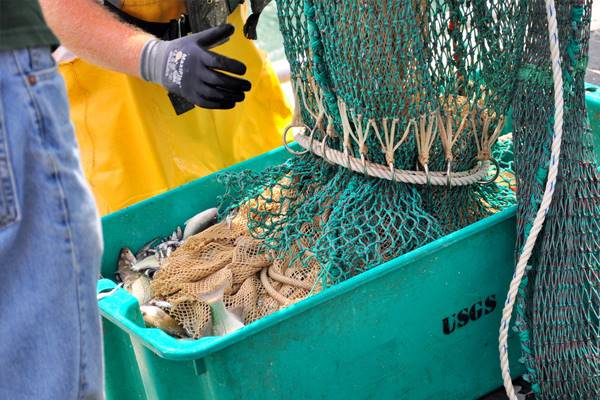Lake Erie’s dead zones more dynamic than once believed; impact fish distribution, study shows
In addition to its size, sea-like hydrology and formerly flammable tributaries, Lake Erie is known for its dead zones. Formed when decomposing organic material on the lakebed consumes oxygen in the water, these dead zones — as their name suggests — are hardly suitable for life.
A new study, led by U.S. Geological Survey scientist Richard Kraus, shows that Erie’s dead zones are far more dynamic than previously thought, changing size and location in a matter of hours. Published in the Canadian Journal of Fisheries and Aquatic Sciences, the study illuminates challenges to fishery management and stock assessments posed by the shifting hypoxia.
Kraus serves as chief of the Lake Erie Biological Station, a research center that helps fishery and resource managers do their jobs. For the past couple of decades, Kraus said, routine recruitment surveys targeting yellow perch have revealed some odd findings.
“Some of the samples that they take in the vicinity of the dead zone, or within the dead zone, wind up showing huge numbers of yellow perch and other species,” Kraus said. “Very strange.” After all, why would fish cluster near the edges of dead zones, rather than spreading out throughout the lake’s better-oxygenated regions?
The findings complicated stock assessments, which calculate fish populations based on sampling. With hypoxic zones influencing fish distribution more than computer models could account for, the Great Lakes Fishery Commission’s Yellow Perch Task Group came to the Lake Erie Biological Station looking for answers.
Kraus and a team of researchers began their study in 2011, initially focusing on well-known processes that lead to hypoxia. While dead zones can form at any time, they’re most common during the summer, when the lake separates into a warm top layer and cool bottom layer. This prevents the layers from mixing, and cuts off the lower layer from access to fresh oxygen.
The researchers took to the lake armed with an assortment of trawl nets and sensors to determine the structure of the water column, dissolved oxygen levels and other hydrological parameters. The team planned the sampling under the impression that Erie’s layers were especially stable, but a more complex reality became apparent from day one.

Trawl net catch rates were highest near the boundaries of the hypoxic zones. (Credit: Andrea Miehls/USGS)
“We did a little reconnaissance in the small boat, came back and said, ‘Okay, here’s the data we’ve got. Here’s the sampling design,’” Kraus said. “We went out and tried to execute it; nothing made sense.”
Extreme variations in dissolved oxygen measurements had baffled the researchers, Kraus said. On one end of their sampling range, oxygen levels spiked, while on the other, the sensors reported hypoxia. Kraus contacted the Ohio DNR with concerns that their instruments were malfunctioning, but the DNR’s response proved that something more complicated than faulty sensors was taking place at the bottom of Lake Erie:
“[My colleague] said, ‘We’re seeing the same thing, I was just about to call you.’”
Kraus and his team deployed a data logger of the lakebed for a month. They were surprised by the readings, which showed that, in a single location, oxygen levels could range from hypoxic to high in the span of a few hours. The team doubled their efforts, deploying more data loggers and trawling nets. They also began conducting surveys to determine what types of fish were hanging around the dead zones.
The study found that internal waves propagated by variations in water temperature and Lake Erie’s unique morphology move dead zones around the bottom of the lake. Fish clustered at the edges of the zones are pushed along as well. While the researchers can’t explain the phenomenon definitively, Kraus said it’s likely that certain fish — especially those with high tolerance to hypoxia, such as yellow perch — congregate at the edges of the dead zones to feed on invertebrates driven from the sediment by lack of oxygen.
According to Kraus, the study will help fishery managers develop new tools to more accurately assess fish stocks and track dead zones. The managers will also have to consider that fish clustered near the dead zones are more vulnerable to angling than those elsewhere. Current management practices assume uniform vulnerability throughout the lake.
The discovery of Erie’s dynamic dead zones could even have political ramifications. The Great Lakes Water Quality Agreement, a set of policies established between the U.S. and Canada, aims in part to reduce the extent of hypoxia in the central basin of Lake Erie. But in light of the new discovery, Kraus said, resource managers may have to rethink their approach to the problem.
“That is going to be challenge,” he said.



0 comments